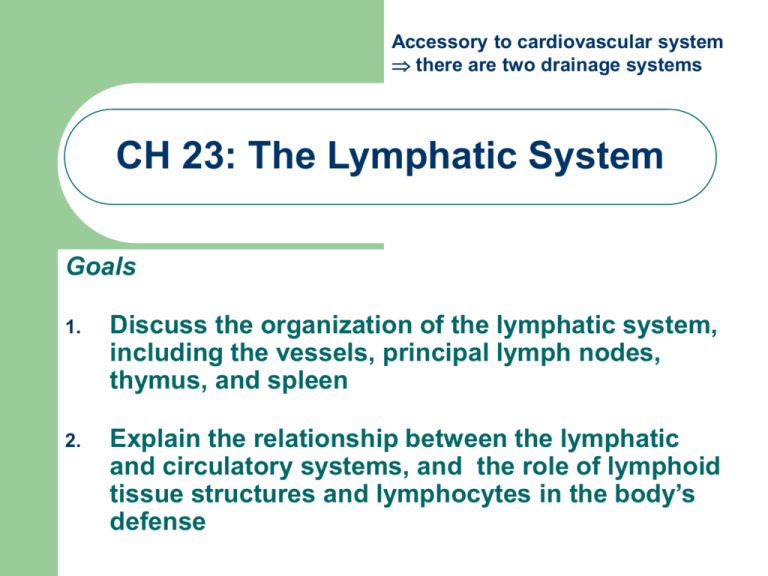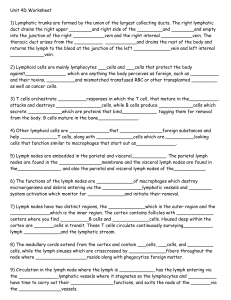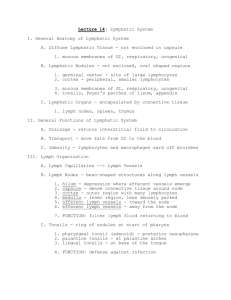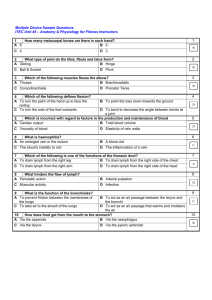CH 23: The Lymphatic System
advertisement

Accessory to cardiovascular system there are two drainage systems CH 23: The Lymphatic System Goals 1. Discuss the organization of the lymphatic system, including the vessels, principal lymph nodes, thymus, and spleen 2. Explain the relationship between the lymphatic and circulatory systems, and the role of lymphoid tissue structures and lymphocytes in the body’s defense Overview of the Lymphatic System Includes, vessels, fluid, and nodes or nonsecreting "glands". Lymphatic vessels convey fluid from the periphery to the veins. The fluid, lymph (=clear spring water), is what seeps out of the blood at the peripheral capillaries. Composition is similar to plasma without the proteins Lymphatic organs or tissues ("glands") are filtering areas and arenas of lymphocyte maturation and competency. Major Functions of Lymphatic System Filtration of lymph Return of seeped fluid to c.v. system “Education” and production of immune system lymphocytes Transport of digested lipids from small intestinal lacteals Lymph Capillaries Compare to Fig. 23.2 Thin walled endothelium (no BM) with periodic one way valves. In general they parallel veins. Closed ends allow fluid flow inward only Pick up and recycle extra tissue fluid Lymph circulation due to ? Location of Lymph Capillaries Everywhere, except for CNS and bone marrow, as well as cornea and cartilage. Special set of lymph capillaries in villi of small intestine = Lacteals Lymphatic vessels comparable in structure to veins Damaged valves or blocked lymph vessels ??? Right lymphatic duct Right subclavian vein Left subclavian vein Thoracic (left lymphatic) duct Lymph capillaries converge to become collecting vessels and end up as either Thoracic duct or right lymphatic duct Cysterna Chyli Fig 23.4 largest Lymphocytes Agranulocytes - large nuclei and small amount of cytoplasm Function in identification and inactivation/destruction of pathogens Types of Lymphocytes 1. T Cells - cellular immunity - specific for previously identified pathogens T Helper, T Killer, T Suppressor, and memory cells 2. 3. B Cells - humoral immunity - plasma cells produce antibodies specific to the antigen or pathogen; memory cells NK cells - non-specific, provide immunological surveillance Bone Marrow: Lymphopoiesis Lymphocytes are later also produced in thymus, spleen and tonsils Fig 23.7 Lymphoid Tissue 1 C.t. loaded with Lymphocytes Lymphoid nodules are unencapsulated clusters of lymphocytes ( ~ 1mm). Found beneath epithelial lining of respiratory, digestive & urinary tracts Mucosa associated lymphatic tissue (MALT) in GI tract – – 5 tonsils aggregate lymphoid nodules in small intestine (= Peyers – patches) appendix - walls contain lymphoid tissue = adenoids 2 2 Lymph Nodes ~ 500 ( 1mm to 25 mm) Bean-shaped with hilus several afferent vessels, one efferent vessel Function? Popular term “lymph gland” is misnomer. Why? Contain lots of lymphocytes & Macrophages Clinical application: Swollen lymph nodes Fig 23.9 Distribution of LNs Cervical lymph nodes - drain head and neck Axillary lymph nodes - drain arms and breasts Popliteal lymph nodes - drain legs, drain into Inguinal lymph nodes - drain lower limb Thoracic lymph nodes - drain thoracic viscera Abdominal lymph nodes - drain pelvic region Intestinal and mesenteric lymph nodes - drain abdominal viscera Thymus Location above heart, posterior to sternum Divided into lobules Only lymphoid organ that does NOT fight antigens, it functions as “T-cell academy” Blood thymus barrier prevents premature stimulation of developing T-cells Involution after puberty Epithelial cells produce thymic hormones Spleen Surfaces named for contacts: diaphragmatic, visceral, gastric, renal Largest lymphoid organ Soft and very blood rich Red pulp sinusoids containing RBCs white pulp lymphoid tissue Fig 23-17 Major Functions: 1. Initiation of Immune response to antigens in blood 2. Removal of aged and defective RBCs 3. Repository for new RBCs 4. Fe salvaging, storage and recycling








